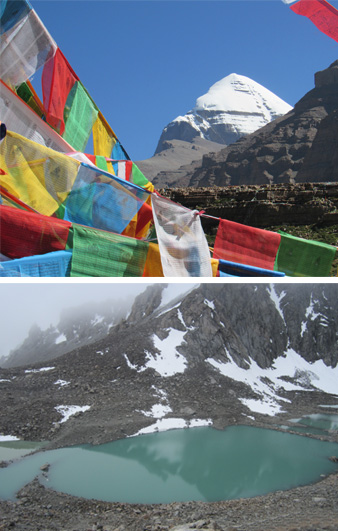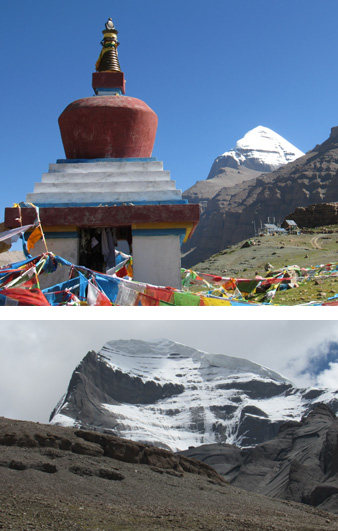
The Kathmandu Lhasa Kailash Ali by drive package program and Mount Kailash (7,714 m) are situated in the Ngri region of Tibet. For Hindus, Mount Kailash is the abode of Shiva, while Tibetan Buddhists worship samvara-a multiarmed, wrathful deity worshipped in the chakra samara Tantric cycle. Mount Kailash is the object of worship for four major religious groups. Additionally, the Indians reverse the mountain as the location of the first emancipation of their saints.
Since its establishment in 2010 AD, Nangri Gunsa Airport (Ali Airport) of Tibet serves both the general public and the military. In terms of altitude, it is the world's fourth highest airport, at 4274m., taking a two-hour flight from Lhasa to Ali Airport, we reach Darchen, located 300 kilometers away from Lake Manasarovar or Darchen. China Airlines offers easy access from Ali Airport to Lhasa airport. The Kailash region is a popular pilgrimage destination for Hindus, Buddhists, Jains and Bonpo. The holy Kailash Parvat is also nearby after reaching Manasarovar. In Tibet, Mount Kailash (6714m.) is a mysterious peak that is worshipped as a dwelling of Gods and Goddesses and as a savior of the universe.
Mount Kailash is considered by Hindus to be the abode of Lord Shiva and his consort Parvati. It is an ultimate way to attain salvation for Hindus to accept the arduous pilgrimage to Kailash and circumambulate the Kailash Parvat called Kailash Kora. As for Moksha, Buddhists worship it as the home of Lord Shakyamuni and often refer to Mount Kailash as Kang Rimpoche. The Jains believe Kailash Parvat was the place where their great guru attained liberation. Kailash Parvat is regarded as the Jewels of Snow in Tibetan Buddhism. The beauty and serenity of Kailash region have become awe-inspiring to the rest of the world due to its religious significance. While performing Kailash Kora, participants must walk 38 km of Kailash Parvat's circumference on foot. All fears and pains are removed by the natural beauty of Kailash region and its diverse flora and fauna. During the circumambulation of Lake Manasarovar, pilgrims can also experience inner peace. Kailash and Manasarovar are visited by a large number of devotees, lamas, saints, and pilgrims every year, demonstrating their great respect and devotion.
 04 June 2025 Day 01: Arrival in Kathmandu before 09:00 A.M.
04 June 2025 Day 01: Arrival in Kathmandu before 09:00 A.M.
Pickup passport, apply Biometric for visa, evening Arati Darshan
05 June 2025 Day 02: Holy sights Saga, Doleshwor Mahadev
Lunch, visit Buddhist temple, evening briefing Kailash tour
06 June 2025 Day 03: Rudra Abhishek, sightseeing Jalnarayan
07 June 2025 Day 04: Fly to Gonggar airport & drive to Lhasa
08 June 2025 Day 05: Sights in Lhasa including Potala Palace
09 June 2025 Day 06: Drive Lhasa to Shigatse 3782m.- Hotel
10 June 2025 Day 07: Drive Shigatse to Saga 4640m. & hotel
11 June 2025 Day 08: Drive to Manasarovar Lake & Overnight
Spiritual ritual Pooja + Full moon night in Manasarovar
12 June 2025 Day 09: Drive to Yam Dwar, start walk –Dirapuk
13 June 2025 Day 10: Visit Charan Sparsh north side of Kailash
14 June 2025 Day 11: Trek to Dolma La 5636m. & Zuthulpuk
15 June 2025 Day 12: Trek to Chongdo, drive to Manasarovar
16 June 2025 Day 13: Drive Ali airport, fly Lhasa, transfer hotel
17 June 2025 Day 14: Drive Gonggar airport, fly to Kathmandu
18 June 2025 Day 15: Transfer to Kathmandu airport departure
Minimum 10 Person or mote
Per Person USD 5500 Double / Twin room sharing basis
Per Person USD 6000 Single room
Hotel in Nepal
Kathmandu: 5 Star Deluxe hotel Radisson, Crown Plaza or Similar
Hotels in Tibet Lhasa & en route
Lhasa Tibet: 5 Star Deluxe hotel Shangri La or Similar
Shigatse: 5 star Gesar Hotel New Building (Full Meals)
Saga: 4 star North Holiday hotel or Similar
Manasarovar Lake: Guest house or mud houses
Darchen: 4 star Himalayan Kailash Hotel
Dirapuk: Normal Guest house (Parikrama first day)
Zuthulpuk: Normal guesthouse (Parikrama second day)
Note: 4 nights in 3 places like Manasarovar Lake, first day of Kora - Dirapuk & second day of Kora -Zuthulpuk will be dromedary bed room and very basic toilets available
 Arrival at Kathmandu, departure transportation from airport
Arrival at Kathmandu, departure transportation from airport  Extra night hotel cost in Kathmandu, Nepal
Extra night hotel cost in Kathmandu, Nepal  Kindly get yourself a Travel medical insurance for this Kailash Manasarovar tour. Please make sure you cover yourself for emergency evacuation (helicopter), road transportation and hotel accommodation in the insurance.
Kindly get yourself a Travel medical insurance for this Kailash Manasarovar tour. Please make sure you cover yourself for emergency evacuation (helicopter), road transportation and hotel accommodation in the insurance.Oxygen is less at higher altitudes. The inclement weather and high altitude induces certain illness generally not encountered over the plains. Headache, nausea, lassitude, lethargy, breathlessness, general uneasiness [malaise], high irritability, light loss of balance, disorientation, incoherence and insomnia are a few. It is common to all irrespective of the age, sex and physical fitness. Gradual acclimatization is the best answer. Tranquilizers, sleeping dose and strong anti-biotic must be avoided. Some of symptoms indicate that the body mechanism is readjusting to new environments. The best idea is deliberately slow down all the activities and follows the following rules
 Chant a prayer or visualize everything around to suit your pleasant thoughts or put on the earphones and listen to your favorite music, Bhajans, chanting etc.
Chant a prayer or visualize everything around to suit your pleasant thoughts or put on the earphones and listen to your favorite music, Bhajans, chanting etc.
Om Namo Shivaya ! Jaya Bhole Nath !! Har Har Mahadev!!!
What our client's says about Kailash yatra and tour operator